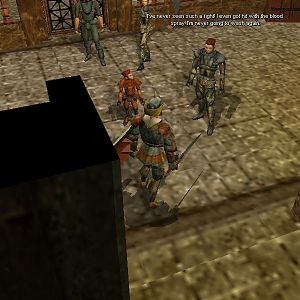-

- Forums
- Chatrooms
- Gallery
- Gameplay Videos
- Upload
- Articles
- Mod Reviews
- Shop SP: Games, Movies, Books

|
History
of Dambrath
|
The nation of Dambrath was formed out of a barbarian kingdom almost a half-millennium ago by a powerful alliance of priestesses of Loviatar and the drow from the city of T'lindhet. In 211 DR, fleeing from the destruction of the homeland by the then-great kingdoms of Unther and Muhlorand, four tribes of barbarians entered Dambrath. They found a coast where the dolphins danced and plains where the grass was long. They roamed from the borders of the Walls of Halruaa as far east as the current borders of Estagund.
They soon became known as the Arkaiun, or people of the wind. In 545 DR a great warchief, Reinhar, arose to lead the tribes. The halflings of Luiren were quickly enslaved, and several of the coastal cities of Durpar were captured or razed. Estagund fell to his rule, and eventually Reinhar turned his attention to Halruaa. An army of 40,000 horsemen and a fleet of 50 ships mounted a coordinated attack, and even though Reinhar was able to get beyond the Walls of Halruaa and occupy the cities of Mithel, Galdel, and Zalsuu, their magics proved to be more than a match for the invaders. Reinhar was finally defeated in a great battle at Sulaziir by the arch mage Mycontil and his troop of wizards.
Reinhar's son, Reinhar II, took command of the army and set out on a two-month overland retreat. He arrived home with a thousand surviving fighting men and no shaman. Reinhar II proved to be as good a ruler in defeat as his father was in war. He consolidated his forces and pulled home almost all of his troops, as he knew that the defeat made them tempting prey for raiders and encroaching monsters. This action allowed for the safe development of his peoples. By the time the ninth Reinhar was king in 802 DR, the Arkaiuns were fat and lazy.
Reinhar IX, or Reinhar the Foolish as he is more commonly known, insisted on expanding his nation to gain more gold to finance his military campaigns. He ordered the mining of many rich lodes of silver and electrum in the Gnollwatch mountains, but before his plans of expansion could begin, the miners encountered the drow of T'lindher. The drow were outraged and began a steady series of raids and attacks on the Arkaiun strongholds. Whole villages were destroyed overnight, and no trace of the invaders could be found. Reinhar IX committed the foolhardy action of attacking the drow in retaliation.
While the Arkaiuns managed to get a force into the drow city, this action only succeeded in uniting the normally chaotic drow. For once, the full power of a drow city was turned against an enemy. The battle quickly moved back to the surface. Reinhar's raiders were wiped out, leaving Reinhar with only a small portion of his original military. This was not enough for the drow, who demanded total enslavement of the entire surface nation. The Arkaiuns resisted valiantly, and the war went on for three decades at tremendous cost in life to both sides. Finally, the drow had the Arkaiun forces cornered at Malduir. Almost without hope, the defenders were overjoyed when a group of half-elven pilgrims appeared on the scene. The high priestess, Cathtyr Shintar, offered the aid of her clerics to help defend the city, and Reinhar took this to be an omen from the gods. A priestess was placed with almost every company. Within a tenday the drow struck.
The priestesses did indeed prove to be of great aid, but to the drow. Every priestess turned on the Arkaiuns, and Cathtyr herself slew Reinhar. The drow were still weakened by the battle, and only the presence of the priestesses enabled them to win. Cathtyr, realizing the unique advantage she possessed, made a deal that ever the suspicious drow embraced. Her priestesses would rule the land, and in exchange they would provide access to the surface for the drow, trading weapons, slaves, and supplies. The drow were delighted with this brazen offer from a surface dweller. Reinhar had been slain and the insult avenged, and after 30 years of war the drow were not particularly interested in Dambrath. They did insist, however, on taking the best captured males as slaves.
Cathtyr quickly agreed to this, seeing the males as an obstacle to her own power. Cathtyr ruled for 205 years. She fulfilled her promise to make Dambrath, or " The Nation of Pain," a bastion of evil in the Realms. In her time, Cathtyr saw the priesthood of Loviatar expand to thousands, and faith in the Beastlords previously worshiped by the Arkaiuns was nearly eradicated. Many of the Arkaiuns were able to escape their new mistresses, and flee to the Swagdar. There they resumed their almost forgotten nomadic life. The priestesses of Loviatar continued to enjoy good relations with the drow, and some even took mates, creating a race of drow half-elves. These dark half-elves became known as the Crintri, or "noble ones."
Most are priestesses of Loviatar, though many are mages as well. They consolidated their power, learning much of the area from the Shebali, or "lower ones," as the Arkaiuns are now called. The capital of Dambrath was established at Cathtyr, built after Cathtyr's passing and named in her honor. Her death came at the hands of her daughter, Filina, who had grown tired of waiting for her mother to die. Filina ruled for only five years, however, before her own daughter, Cathakay, assumed the throne in the same fashion. Cathakay ruled for 54 years, eventually falling in battle against a gold dragon. She died childless, and her niece Melanith assumed the throne. Melanith faced an increasing population, and unrest among males who longed for a return to their prestige of old. Melanith did not return their previous status, but she did make use of them.
Fearing that the great nations of Mulhorand and Unther might rise again, she decided that mundane tasks, such as defense of the kingdom, would be handled by men. She was the first to name a male to the post of warchief. Sadalar, a Crintri, became the queen's consort. His term as warchief was characterized by widespread bribery and corruption. He was, however, responsible for getting many privileges returned to the Arkaiuns. After Melanith's rule, the Shebali were considered second class citizens, rather than slaves. Though males were granted more power during her rule, Melanith also solidified the split between the sexes. While the rulers of Dambarth had been females for over two centuries, it was more because of competence than gender.
Melanith, however, decreed that men could have no authority except over other men. The female-led hierarchy of Loviatar was quick to back this move. Many of the bravest and best men of the kingdom perished in raids on Estagund, Durpar, the bandit tribes of Veldorn, and against the gnolls that had returned to the Gnollwarch mountains. Some even fought at the side of the drow in their battle with the svirfneblin city of Aventine. The deep gnomes were destroyed, but so were the Shebali. The drow and the Crintri were largely unharmed, and for their aid, the Crintri were rewarded with a number of drow males to breed in to their race.
Melanith took a drow male as her consort to replace Sadalar, who had perished in the conflict. The drow, Nym Inthigg, fathered three daughters and a son. It was at this time that Melantih began the isolationist policy that Dambrath still follows today. Melanith ruled for 156 years; her daughter Ausitil for 125. The current queen of Dambrath Yenandra, who is known in Dambarth as the "Pirate Queen," is said to have sailed as far south as Zakhara on pillaging raids. Yenandra has been ruling for 71 years, and is beginning to show signs of age. She has three daughters as well, named Luatharyn, Meltruil, and Hasafir. While she does remain extremely popular, especially to the Crintri, the children of leaders in this land are not known to patiently wait their turn.


